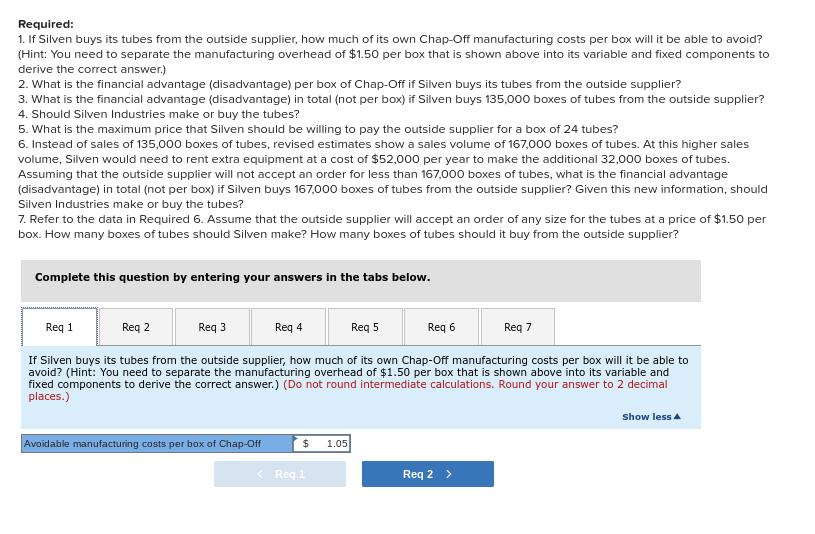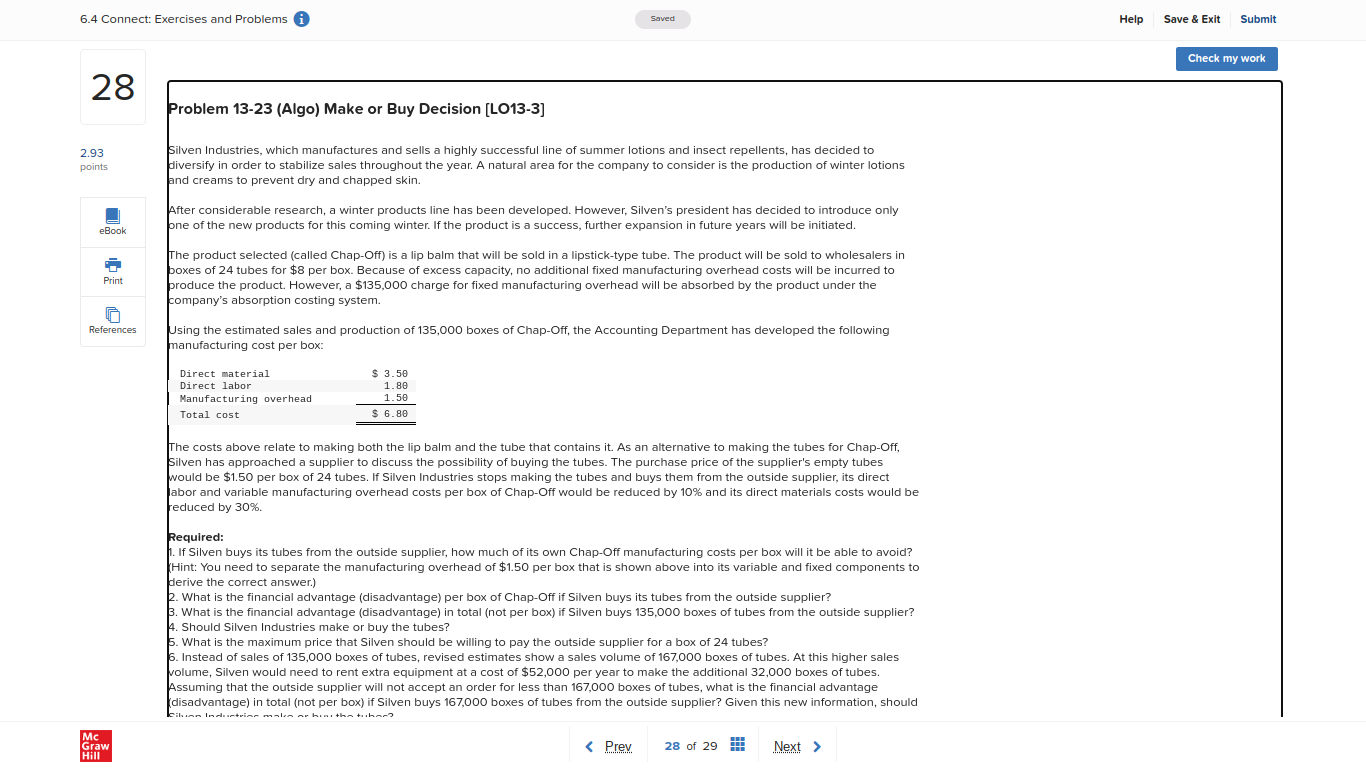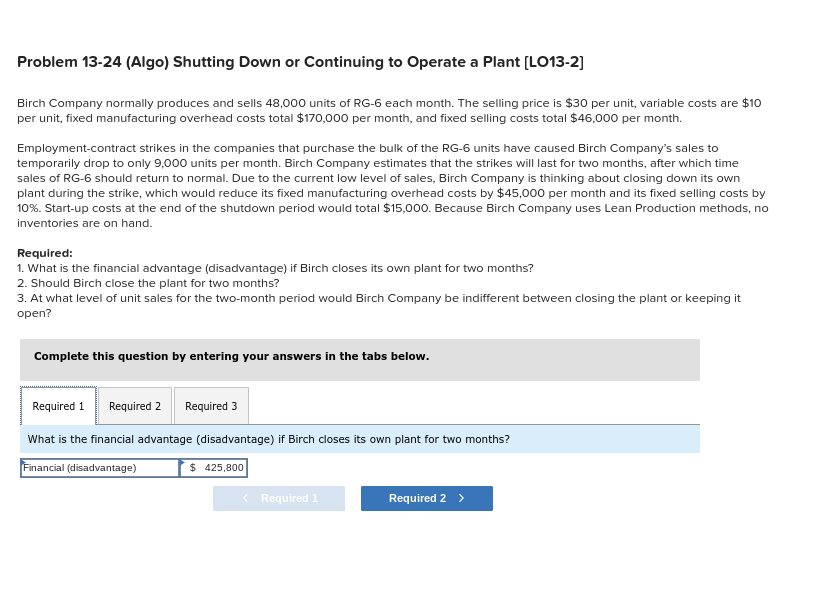Answered step by step
Verified Expert Solution
Question
1 Approved Answer
Required: 1. If Silven buys its tubes from the outside supplier, how much of its own Chap-Off manufacturing costs per box will it be



Required: 1. If Silven buys its tubes from the outside supplier, how much of its own Chap-Off manufacturing costs per box will it be able to avoid? (Hint: You need to separate the manufacturing overhead of $1.50 per box that is shown above into its variable and fixed components to derive the correct answer.) 2. What is the financial advantage (disadvantage) per box of Chap-Off if Silven buys its tubes from the outside supplier? 3. What is the financial advantage (disadvantage) in total (not per box) if Silven buys 135,000 boxes of tubes from the outside supplier? 4. Should Silven Industries make or buy the tubes? 5. What is the maximum price that Silven should be willing to pay the outside supplier for a box of 24 tubes? 6. Instead of sales of 135,000 boxes of tubes, revised estimates show a sales volume of 167,000 boxes of tubes. At this higher sales volume, Silven would need to rent extra equipment at a cost of $52,000 per year to make the additional 32,000 boxes of tubes. Assuming that the outside supplier will not accept an order for less than 167,000 boxes of tubes, what is the financial advantage (disadvantage) in total (not per box) if Silven buys 167,000 boxes of tubes from the outside supplier? Given this new information, should Silven Industries make or buy the tubes? 7. Refer to the data in Required 6. Assume that the outside supplier will accept an order of any size for the tubes at a price of $1.50 per box. How many boxes of tubes should Silven make? How many boxes of tubes should it buy from the outside supplier? Complete this question by entering your answers in the tabs below. Req 1 Req 2 Req 3 Req 4 Req 5 Req 6 Req 7 If Silven buys its tubes from the outside supplier, how much of its own Chap-Off manufacturing costs per box will it be able to avoid? (Hint: You need to separate the manufacturing overhead of $1.50 per box that is shown above into its variable and fixed components to derive the correct answer.) (Do not round intermediate calculations. Round your answer to 2 decimal places.) Avoidable manufacturing costs per box of Chap-Off < Req 1 $ 1.05 Req 2 > Show less 6.4 Connect: Exercises and Problems 28 Problem 13-23 (Algo) Make or Buy Decision [LO13-3] Saved 2.93 points eBook Print References Silven Industries, which manufactures and sells a highly successful line of summer lotions and insect repellents, has decided to diversify in order to stabilize sales throughout the year. A natural area for the company to consider is the production of winter lotions and creams to prevent dry and chapped skin. After considerable research, a winter products line has been developed. However, Silven's president has decided to introduce only one of the new products for this coming winter. If the product is a success, further expansion in future years will be initiated. The product selected (called Chap-Off) is a lip balm that will be sold in a lipstick-type tube. The product will be sold to wholesalers in boxes of 24 tubes for $8 per box. Because of excess capacity, no additional fixed manufacturing overhead costs will be incurred to produce the product. However, a $135,000 charge for fixed manufacturing overhead will be absorbed by the product under the company's absorption costing system. Using the estimated sales and production of 135,000 boxes of Chap-Off, the Accounting Department has developed the following manufacturing cost per box: Direct material Direct labor Manufacturing overhead Total cost $ 3.50 1.80 1.50 $ 6.80 The costs above relate to making both the lip balm and the tube that contains it. As an alternative to making the tubes for Chap-Off, Silven has approached a supplier to discuss the possibility of buying the tubes. The purchase price of the supplier's empty tubes would be $1.50 per box of 24 tubes. If Silven Industries stops making the tubes and buys them from the outside supplier, its direct labor and variable manufacturing overhead costs per box of Chap-Off would be reduced by 10% and its direct materials costs would be reduced by 30%. Required: If Silven buys its tubes from the outside supplier, how much of its own Chap-Off manufacturing costs per box will it be able to avoid? Hint: You need to separate the manufacturing overhead of $1.50 per box that is shown above into its variable and fixed components to derive the correct answer.) 2. What is the financial advantage (disadvantage) per box of Chap-Off if Silven buys its tubes from the outside supplier? 3. What is the financial advantage (disadvantage) in total (not per box) if Silven buys 135,000 boxes of tubes from the outside supplier? 4. Should Silven Industries make or buy the tubes? 5. What is the maximum price that Silven should be willing to pay the outside supplier for a box of 24 tubes? 6. Instead of sales of 135,000 boxes of tubes, revised estimates show a sales volume of 167,000 boxes of tubes. At this higher sales volume, Silven would need to rent extra equipment at a cost of $52,000 per year to make the additional 32,000 boxes of tubes. Assuming that the outside supplier will not accept an order for less than 167,000 boxes of tubes, what is the financial advantage (disadvantage) in total (not per box) if Silven buys 167,000 boxes of tubes from the outside supplier? Given this new information, should Siluma Invalusteine makes me bine the tuhand Mc Graw Hill < Prev 28 of 29 Next > Help Save & Exit Submit Check my work Problem 13-24 (Algo) Shutting Down or Continuing to Operate a Plant [LO13-2] Birch Company normally produces and sells 48,000 units of RG-6 each month. The selling price is $30 per unit, variable costs are $10 per unit, fixed manufacturing overhead costs total $170,000 per month, and fixed selling costs total $46,000 per month. Employment-contract strikes in the companies that purchase the bulk of the RG-6 units have caused Birch Company's sales to temporarily drop to only 9,000 units per month. Birch Company estimates that the strikes will last for two months, after which time sales of RG-6 should return to normal. Due to the current low level of sales, Birch Company is thinking about closing down its own plant during the strike, which would reduce its fixed manufacturing overhead costs by $45,000 per month and its fixed selling costs by 10%. Start-up costs at the end of the shutdown period would total $15,000. Because Birch Company uses Lean Production methods, no inventories are on hand. Required: 1. What is the financial advantage (disadvantage) if Birch closes its own plant for two months? 2. Should Birch close the plant for two months? 3. At what level of unit sales for the two-month period would Birch Company be indifferent between closing the plant or keeping it open? Complete this question by entering your answers in the tabs below. Required 1 Required 2 Required 3 What is the financial advantage (disadvantage) if Birch closes its own plant for two months? Financial (disadvantage) $ 425,800 < Required 1 Required 2 >
Step by Step Solution
There are 3 Steps involved in it
Step: 1

Get Instant Access to Expert-Tailored Solutions
See step-by-step solutions with expert insights and AI powered tools for academic success
Step: 2

Step: 3

Ace Your Homework with AI
Get the answers you need in no time with our AI-driven, step-by-step assistance
Get Started


